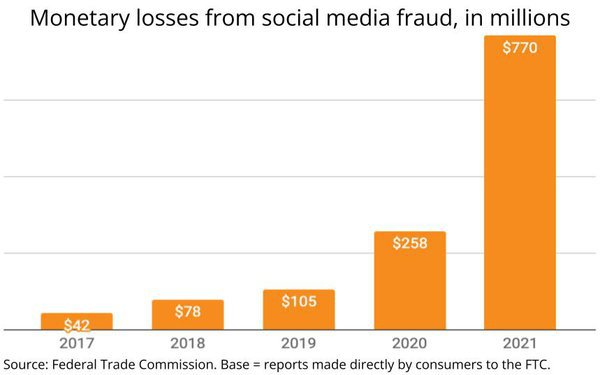
The Federal Trade Commission (FTC) reports that in 2021, consumers lost
$770 million to social media scams, as part of its latest Consumer Protection Data Spotlight report.
This figure -- which makes up 25% of the year's total fraud losses -- has increased by 18
times (or $728 million) versus 2017.
Emerging cryptocurrency and ecommerce technologies have created a plethora of new kinds of scams, according to the report.
The FTC also found that those being targeted were
also younger, with consumers between the ages of 18 and 39 reporting fraud at 2.4 times higher rate than those above the age of 40.
Social media is the clear gateway for scammers to reach this
younger audience. The report shows that social media is where 95,000 fraud victims were first contacted.
This statistic is up 19 times from 2017, and has doubled since 2020. In terms of total
fraud-related losses in 2021, 26% ($770 million) were due to social media.
Fraud conducted on websites and apps was 19% ($554 million), and fraud via phone calls was 18% ($546
million).
Most reports of fraudulent social media –– a total of 45% –– involved people losing money to online shopping scams. “Most of the reports about online
shopping scams involved someone who ordered a product they saw marketed on social media that never arrived,” the FTC report says.
Facebook and Instagram were listed as the two top social
media platforms where undelivered products were marketed, appearing in 9 out of 10 reported scams.
User doubt surrounding the legitimacy of in-app online shopping opportunities could have a
significant negative impact on the future of ecommerce.
Facebook and Instagram were also most popular among scammers who sent “innocent” friend requests to users, flirted
with them romantically, and then requested money. Twenty-three percent of romance scams were linked to Facebook, and 13% to Instagram.
Fifty-four percent of investment scams also involved
social media platforms, where users were faced with fake investment opportunities. Thirty-six percent of these scams took place on Instagram, 28% on Facebook, 9% on WhatsApp (another Meta-owned
company) and 7% on Telegram.
Scams could become more prevalent due to
other Meta-created products, such as their virtual reality (VR) headsets, having just changed names from “Oculus Quest” to “Meta Quest.” Used primarily by Gen Z and
Millennials, these VR technologies may continue the trend of scamming younger, more vulnerable users.